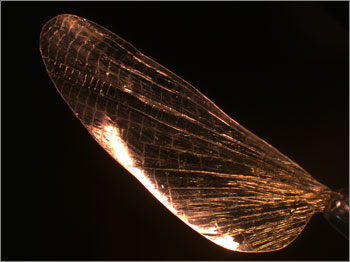
BOSTON – Researchers at the Wyss Institute for Biologically Inspired Engineering at Harvard University have developed a new material that replicates the exceptional strength, toughness, and versatility of one of nature’s more extraordinary substances — insect cuticle. Also low-cost, biodegradable, and biocompatible, the new material, called “Shrilk,” could one day replace plastics in consumer products and be used safely in a variety of medical applications.
The research findings appear today in the online issue of Advanced Materials. The work was conducted by Wyss Institute postdoctoral fellow, Javier G. Fernandez, Ph.D., with Wyss Institute Founding Director Donald Ingber, M.D., Ph.D. Ingber is the Judah Folkman Professor of Vascular Biology at Harvard Medical School and Children’s Hospital Boston and is a Professor of Bioengineering at the Harvard School of Engineering and Applied Sciences.
Natural insect cuticle, such as that found in the rigid exoskeleton of a housefly or grasshopper, is uniquely suited to the challenge of providing protection without adding weight or bulk. As such, it can deflect external chemical and physical strains without damaging the insect’s internal components, while providing structure for the insect’s muscles and wings. It is so light that it doesn’t inhibit flight and so thin that it allows flexibility. Also remarkable is its ability to vary its properties, from rigid along the insect’s body segments and wings to elastic along its limb joints.
Insect cuticle is a composite material consisting of layers of chitin, a polysaccharide polymer, and protein organized in a laminar, plywood-like structure. Mechanical and chemical interactions between these materials provide the cuticle with its unique mechanical and chemical properties. By studying these complex interactions and recreating this unique chemistry and laminar design in the lab, Fernandez and Ingber were able to engineer a thin, clear film that has the same composition and structure as insect cuticle. The material is called Shrilk because it is composed of fibroin protein from silk and from chitin, which is commonly extracted from discarded shrimp shells.
Shrilk is similar in strength and toughness to an aluminum alloy, but it is only half the weight. It is biodegradable and can be produced at a very low cost, since chitin is readily available as a shrimp waste product. It is also easily molded into complex shapes, such as tubes. By controlling the water content in the fabrication process, the researchers were even able to reproduce the wide variations in stiffness, from elasticity to rigidity.
These attributes could have multiple applications. As a cheap, environmentally safe alternative to plastic, Shrilk could be used to make trash bags, packaging, and diapers that degrade quickly. As an exceptionally strong, biocompatible material, it could be used to suture wounds that bear high loads, such as in hernia repair, or as a scaffold for tissue regeneration.
“When we talk about the Wyss Institute’s mission to create bioinspired materials and products, Shrilk is an example of what we have in mind,” said Ingber. “It has the potential to be both a solution to some of today’s most critical environmental problems and a stepping stone toward significant medical advances.”
Contact
Twig Mowatt
E-Mail: twig.mowatt@wyss.harvard.edu
About the Wyss Institute for Biologically Inspired Engineering at Harvard University
The Wyss Institute for Biologically Inspired Engineering at Harvard University uses Nature’s design principles to develop bioinspired materials and devices that will transform medicine and create a more sustainable world. Working as an alliance among Harvard’s Schools of Medicine, Engineering, and Arts & Sciences, and in partnership with Beth Israel Deaconess Medical Center, Brigham and Women’s Hospital, Children’s Hospital Boston, Dana Farber Cancer Institute, Massachusetts General Hospital, the University of Massachusetts Medical School, Spaulding Rehabilitation Hospital, and Boston University, the Institute crosses disciplinary and institutional barriers to engage in high-risk research that leads to transformative technological breakthroughs. By emulating Nature’s principles for self-organizing and self-regulating, Wyss researchers are developing innovative new engineering solutions for healthcare, energy, architecture, robotics, and manufacturing. These technologies are translated into commercial products and therapies through collaborations with clinical investigators, corporate alliances, and new start-ups.
Source
Wyss Institute at Harvard, press release, 2011-12-13.
Supplier
Share
Renewable Carbon News – Daily Newsletter
Subscribe to our daily email newsletter – the world's leading newsletter on renewable materials and chemicals













